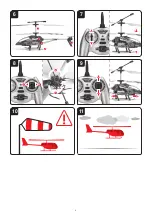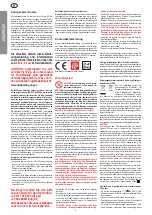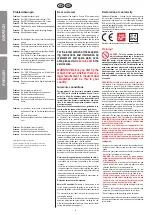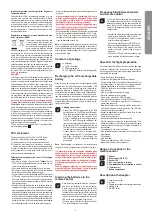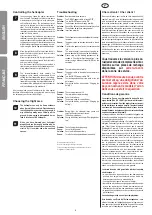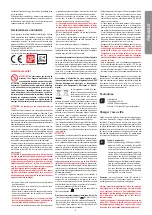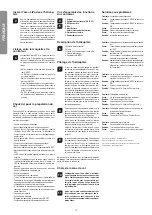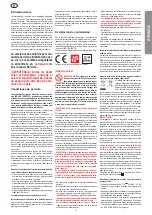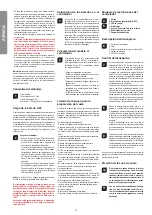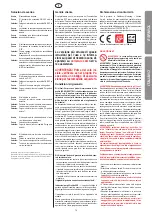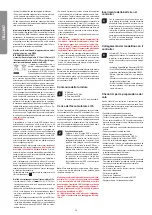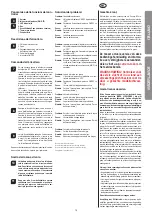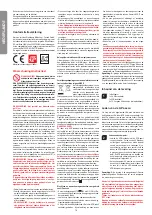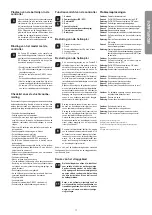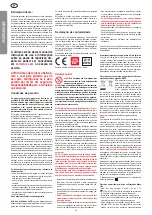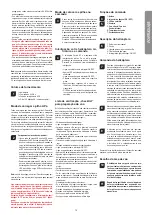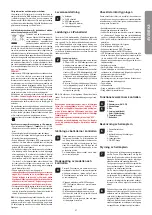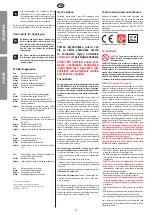
7
Important information concerning Lithium Polymer re-
chargeable batteries
Lithium-Polymer (LiPo) rechargeable batteries are sig-
nificantly more sensitive than traditional alkali- or NiMH-
rechargeable batteries which are normally used with radio
control units. Therefore the instructions and warnings have
to be observed in detail. In case of improper use of LiPo
rechargeable batteries there is a danger of fire. Always fol-
low the manufacturers´ instructions if you dispose of LiPo
rechargeable batteries.
Regulations on disposal for waste electrical and elec-
tronic equipment (WEEE)
This symbol, showing refuse bins with
a cross through them, denotes that
empty batteries, rechargeable batter-
ies, button cells, recharge able battery
packs, equipment batteries, disused
electrical equipment, etc. should not be disposed of in do-
mestic refuse, as they are harmful to the environment and
health. Please help to preserve environment and health and
talk to your children about the correct disposal of used bat-
teries and disused electrical equipment. Batteries and dis-
used electrical equipment should be handed in to the usual
collection points where they can be properly recycled.
Do not mix dissimilar battery types or employ new and used
batteries together. Empty batteries should be removed from
the product. Do not recharge non-rechargeable batteries
due to risk of explosion.
WARNING!
This charger respectively USB-adapter can be used by chil-
dren aged from 8 years and above and persons with reduced
physical, sensory or mental capabilities or lack of experience
and knowledge if they have been given supervision or in-
struction concerning use of the charger respectively USB-
adapter in a safe way and understand the hazards involved.
Children shall not play with the USB-adapter. Cleaning and
user maintenance shall not be made by children unless they
are older than 8 and supervised. Keep the charger respec-
tively USB-adapter and its cord out of reach of children less
than 8 years.
Never leave the battery unattended while it is
charging
Exhausted batteries are to be removed from the toy.
Rechargeable batteries should be removed from the product
before charging. Supply terminal are not to be short-circuited.
Only use the batteries recommended or equivalent types.
If in regular use the charger must be examined for damage
to the cord, plug, covers and all other parts. If any signs of
damage are found the charger may only be used again after
repair work has been completed. The external flexible cable
or cord of this charger cannot be replaced: If the cord is dam-
aged the charger shall be scrapped.
The toy is only to be connected to Class II equipment bear-
ing the following symbol.
FCC statement
This device complies with Part 15 of the FCC Rules.
Operation is subject to the following two conditions:
(1) this device may not cause harmful interference, and
(2) this device must accept any interference received, in-
cluding interference that may cause undesired operation.
Changes or modifications not expressly approved by the
party responsible for compliance could void the user’s
authority to operate the equipment.
Guidelines and warnings for the use of LiPo recharge-
able batteries
• You have to charge the attached 3.7 V 850 mAh /
3.15 Wh LiPo rechargeable battery in a safe place and at a
safe distance to flammable material.
• Never leave the battery unattended while it is charging
• After a flight, the rechargeable battery has to cool down to
the ambient air temperature before charging it.
• You must always use the corresponding LiPo charging unit
(USB cable / remote control). In case of non-compliance
with these directions there is a danger of fire resulting in
a health risk and/or damage to property. NEVER use any
other battery charger.
• Should the rechargeable battery swell or deform while dis-
charging or recharging, you have to immediately stop charg-
ing or discharging the battery. Take the battery out as quickly
and carefully as possible and place it in a safe and open area
offside any inflammable material and watch it for at least 15
minutes. In case you continue charging or discharging a bat-
tery which has already started to swell or deform there is a
danger of fire! Even in case of slight deforming or ballooning
the rechargeable battery has to be taken out of operation.
• Store the rechargeable battery at ambient temperature in a
dry place.
•
Always recharge the battery immediately after use to
prevent its becoming deep discharged. Please make
sure to allow a pause of about 20 minutes between
finishing the flight and recharging the battery.
Recharge the battery occasionally (suggested every
2-3 months). Failure to treat the battery as described
above can lead to its becoming defective.
• When transporting or temporarily storing the rechargeable
battery the temperature should be between 5-50°C. If pos-
sible, do not store the battery or the model in a car and do
not expose it to direct sunlight. In case the battery is broiled
it can be damaged or catch fire.
Note:
If the battery voltage/output is low you will recognise
that a considerable trim and/or controlling is necessary to
avoid that the helicopter starts trundling. This usually occurs
before reaching a battery voltage of 3 V and it is a good mo-
ment to end the flight.
Contents of package
1
1x Helicopter
1x 2.4 GHz Controller
1x USB charging cable
4x 1.5 V Mignon AA batteries (non-rechargeable)
Recharging the LiPo rechargeable
battery
Make sure you only charge the LiPo rechargeable battery
supplied with the LiPo charging unit also supplied (USB
cable and remote control). In case you try to charge the re-
chargeable battery with a different LiPo battery charger or
any other battery charger, this might cause serious damag-
es. Please carefully read the previous chapter about warn-
ings and guidelines on the usage of rechargeable batteries
before proceeding. Rechargeable batteries should only be
charged under adult supervision. Supply terminals are not
to be short-circuited.
2
Charging via computer:
• Connect the USB charging cable with the USB
port of a computer. The LED on the USB charger
cable lights green indicating that the charger unit
is correctly connected to the computer. If you
plug in a helicopter with a discharged battery,
the LED on the USB charging cable does not
light up; this shows that the helicopter battery is
being charged. The USB charging cable and the
charging socket on the helicopter are designed
to make incorrect connection impossible.
• It takes about 80 minutes to recharge a dis-
charged battery (but NOT a deep-discharged
one).When the battery is fully charged, the
LED display on the USB charger cable lights up
green again.
Note:
When supplied, the lipo-battery is already partially
charged so the first charging cycle may well take less time.
It is essential to follow the connection sequence given
above! If you have the charger cable only connected to
the helicopter and not to a source of electricity, please
note the following: The green LED display does not nec-
essarily indicate the battery is still adequately charged.
While charging, the power switch must be in the “OFF”
position.
Undo the plugged connection on the helicopter if you
are not going to use the helicopter. Failure to observe
this precaution may cause battery damage!
Inserting the batteries in the
remote control
3
Open the battery compartment with a screwdriver
and insert the batteries in the remote control.
Please keep in mind the correct polarity. After
having closed the compartment you can check all
functions of the remote control with the help of the
power-switch on the front. With the power-switch
turned ON and proper functioning, the top center
LED on the remote control will light up red.
When the control LED flashes rapidly, the batter-
ies in the controller must be changed.
Frequency bind between model
and remote control
4
The Carrera RC helicopter and the remote control
are frequency bound at purchase. Should there
occur any problems with the communication be-
tween the Carrera RC helicopter and the remote
control at the beginning, please carry out a new
frequency bind.
• Connect the plug-in connection at the model and
switch on the model at the ON/OFF switch.
• The LED in the helicopter now flashes in rhyth-
mically-accelerating sequence.
• Switch on the controller at the ON/OFF switch.
• Place the charged helicopter on a flat surface.
• Allow the helicopter a few moments until the
system is correctly initialised and is ready for
operation.
• The control LED now lights continuously once
again, indicating that the connection is ended.
Checklist for flight preparation
This checklist does not replace the contents of the operating
instructions. Although it can be used as a quick-start-guide
we strongly advise to first read the operating instructions in
detail before you proceed.
• Check the contents of the package
• Connect the charging unit to the source of power.
• Charge the lipo-battery as described in the section “Charg-
ing the lipo-battery”. In order to fly after charging, make the
plugged connection to be found on the helicopter.
• Fit four AA batteries in the controller, making sure their po-
larity is correct.
• Look for a suitable environment for flying
• Place the helicopter on a flat surface
• Switch on the model at the ON/OFF switch.
• Turn the remote control on at the ON/OFF switch.
• The LED in the helicopter now flashes in rhythmically-
accelerating sequence.
• Allow the helicopter a few moments until the system is cor-
rectly initialised and is ready for operation. The LED in the
helicopter now lights continuously.
• Repeat the above points as required, if you wish to fly more
helicopters at the same time.
• Check the control system
• Make yourself familiar with the control system
• Trim the helicopter as necessary as described under “Con-
trolling the helicopter”, so that when hovering the helicopter
no longer moves from the spot, until given a command by
the controller.
• The helicopter is now ready to be flown.
• If the helicopter displays no functions, retry the above bind-
ing procedure.
• Fly the model
• Land the model
• Switch the model off at the ON/OFF switch
• Always switch off the remote control last
Range of functions of the
remote control
3
1. Antenna
2. Power switch (ON / OFF)
3. Control LED
5
4. Gas · tail (spinning in circles)
5. Forward/backward tail (spinning in circles)
6. Trimmer for tail
7. Battery compartment
Description of helicopter
6
1. Coaxial rotor system
2. Tail rotor
3. Plugged connection for charging the lipo battery.
4. Landing skids
5. ON-/OFF switch
EN
G
LI
S
H



